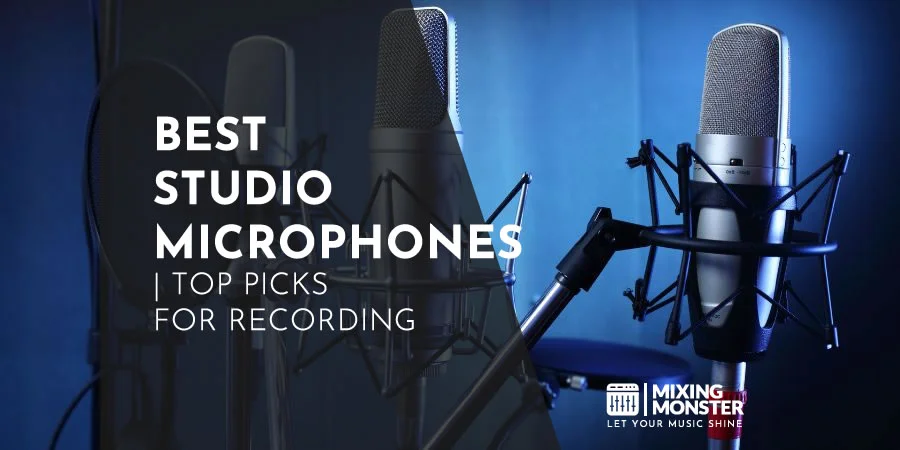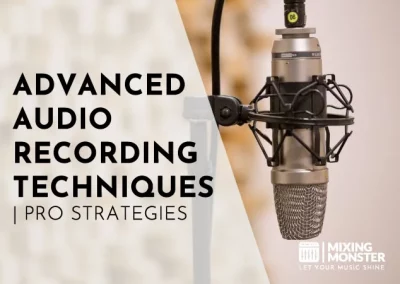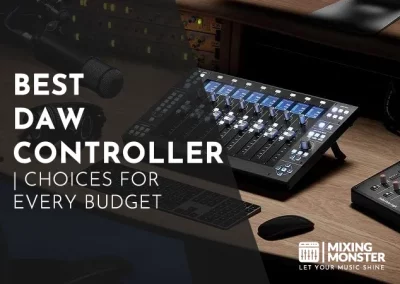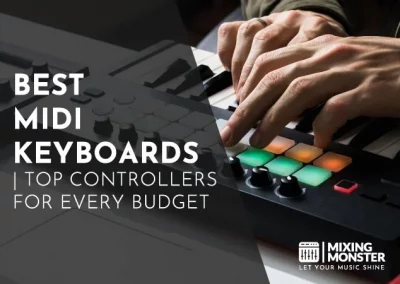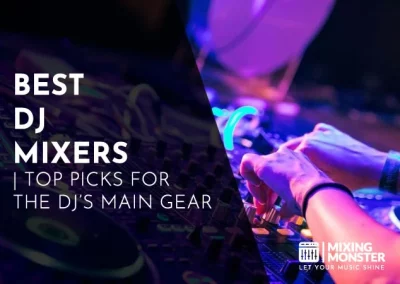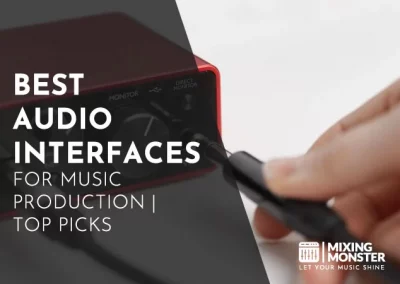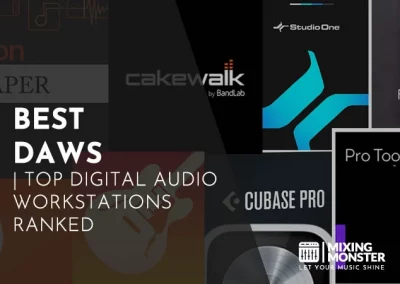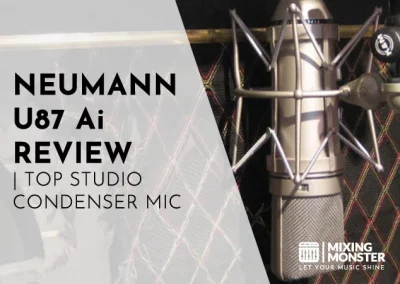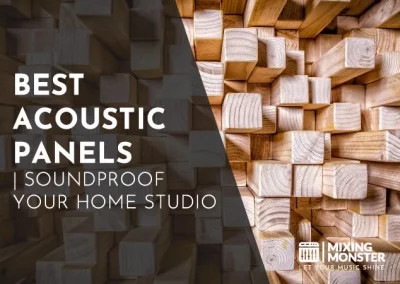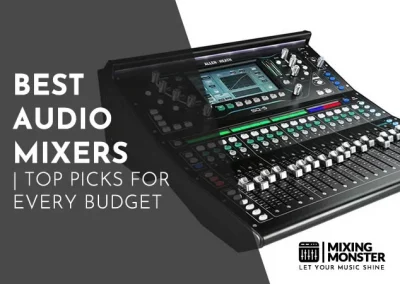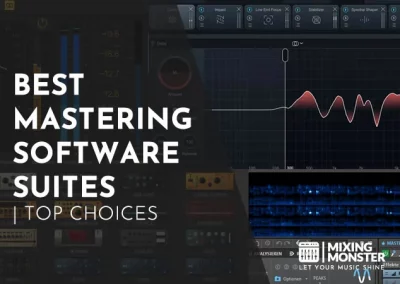Home > Blog > Studio Gear > Home Studio Gear
Disclosure: Some of the links below are affiliate links, meaning that at no additional cost to you, we will receive a commission if you click through and make a purchase. Read our full affiliate disclosure here.
Capturing the perfect sound in a recording studio starts with an essential piece of equipment: the microphone. It serves as the critical bridge between the source of the sound and its digital capture. With countless musical nuances at stake, selecting the best studio microphone is not merely a technicality—it’s an art form.
Studio microphones are precision tools designed to capture sound with clarity, fidelity, and sensitivity. They come in various types, including dynamic, condenser, and ribbon microphones, each with unique properties and preferred applications. Dynamic microphones, rugged and reliable, are ideal for capturing loud, robust sounds like drums and electric guitars. Condenser microphones, known for their broader frequency response and higher sensitivity, are the favorites for vocals and acoustic instruments. With their figure-8 polar pattern and warm sound characteristics, Ribbon microphones capture room ambiance and nuanced performances.
When choosing a studio microphone, one must consider pickup patterns, frequency response, signal-to-noise ratio, and whether the microphone requires phantom power. Recording enthusiasts and sound engineers understand the excitement and overwhelming nature of finding a microphone that brings out the best in every performance.
It is crucial to focus on aspects like the microphone’s compatibility with your studio setup, the types of instruments or vocals you plan to record, and your preferences regarding warmth, clarity, and sound intensity. We spent extensive time testing and analyzing studio microphones to guide you in making an informed decision—a decision that will elevate your recordings from good to extraordinary.
KEYNOTES:
- In this article, you’ll find a comprehensive list of the best studio microphones on the market.
- Studio microphones are categorized into 3 sections:
Best Budget Studio Microphones
Best Midrange Studio Microphones
Best High-End Studio Microphones - Each section contains:
5 Studio Microphones
ordered by price (low > high)
Our Top Picks – Best Studio Microphones
Table Of Contents
1. What Are The Best Studio Microphones?
Best Budget Studio Microphones
Best Midrange Studio Microphones
Best High-End Studio Microphones
2. What Is A Studio Microphone?
3. Studio Microphone Buying Guide
4. Finding Your Perfect Studio Microphone: Key Takeaways
5. FAQ

1. What Are The Best Studio Microphones?
We understand the importance of capturing crisp and clear audio for podcasts, music production, or voice-over work. Our selection encompasses a range of studio microphones that stand out for their audio quality, build, and reliability. Each has been vetted for performance, ensuring it meets the demands of professionals and enthusiasts alike.
Here Are Our Picks For The Best Studio Microphones:
Best Budget Studio Microphones
1. AKG P3S
Dynamic Microphone
Best For Live Performing Beginners
2. sE Electronics X1 A
Condenser Microphone
Best For Small Home Studios And Vocal Recording
3. Audio-Technica AT2020
Condenser Microphone
Best For Home Studios Voiceovers And Project Recording
4. Shure SM57-LCE
Dynamic Microphone
Best For Studio Recording And Live Sound
5. Heil Sound PR22-UT
Dynamic Microphone
Best For Live Vocalists And Recording Artists
Best Midrange Studio Microphones
6. Shure BETA 58A
Dynamic Microphone
Best For Live Vocal Performances And Studio Vocal Sessions
7. Shure 55SH Series II Retro
Dynamic Microphone
Best For Performers And Broadcasters Seeking Vintage Style With Modern Quality
8. Sennheiser E906
Dynamic Microphone
Best For Guitar Amps And Percussion
9. Rode NT1-5th Generation
Condenser Microphone
Best For Professional-Grade Home Recording
10. Warm Audio WA-47jr
Condenser Microphone
Best For Versatile Recording And Sound Faithful To The Classic ’47 Mic
Best High-End Studio Microphones
11. Shure SM7B
Dynamic Microphone
Best For Professional Studio Recording, Streaming And Broadcasting
12. Beyerdynamic M 160
Ribbon Microphone
Best For Studio Recording And Acoustic Instruments
13. AKG C414 XLII
Condenser Microphone
Best For Professional Studios And Discerning Audiophiles
14. Neumann TLM 103
Condenser Microphone
Best Overall Professional Studio Quality Microphone
15. Neumann U 87 Ai
Condenser Microphone
Best For Studio Recording Enthusiasts And Collectors
Best Budget Studio Microphones
#1 AKG P3S
Best For Live Performing Beginners
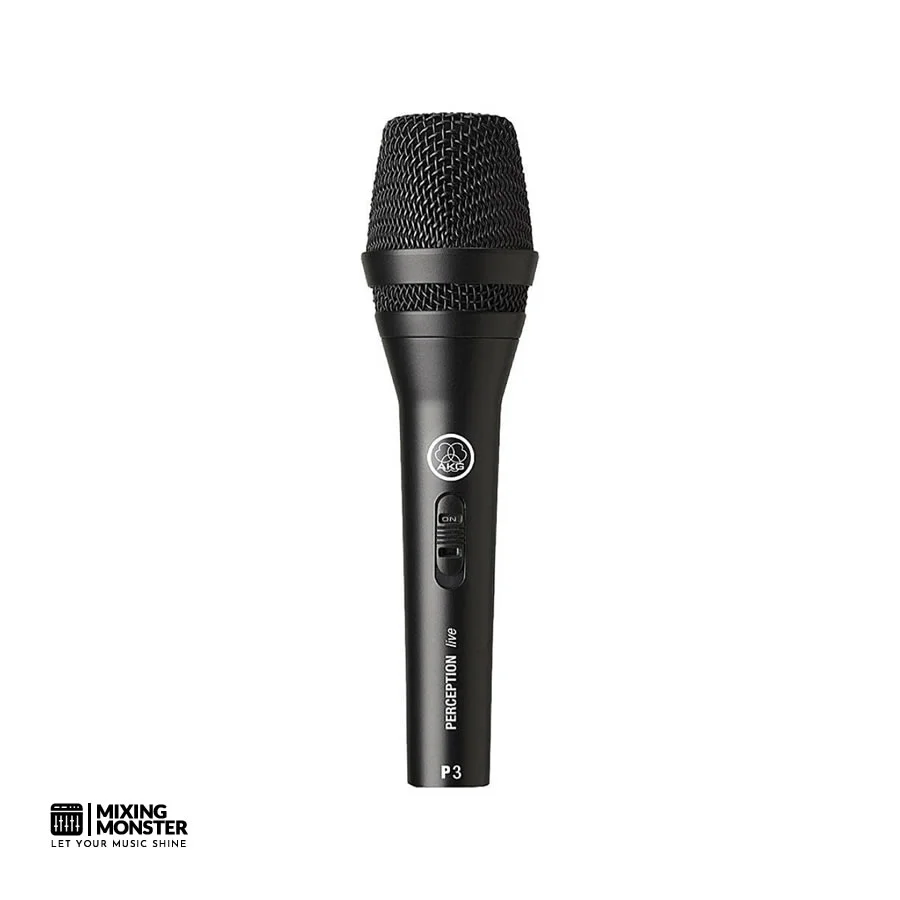
Overview:
After experimenting with the AKG P3S, we’re convinced it suits vocalists and instrumentalists seeking a robust mic that doesn’t break the bank.
Pros:
- Withstands frequent use with a rugged construction
- The on/off switch offers convenient sound control
- Cardioid pattern cuts down on unwanted ambient noise
Cons:
- Lacks versatility for more refined studio recording setups
- Brightness in the high-end might be too sharp for some preferences
- It may require additional equipment for optimal performance
Unique Selling Point:
The AKG P3S differentiates itself through a combination of durability, simplicity, and focused sound capture, which makes it a workhorse microphone for live scenarios.
Key Benefits:
- The solid metal body and mesh cap guarantee longevity, even in the hands of the most enthusiastic performers.
- An on/off switch directly on the mic allows for quick muting, an essential feature for live setups.
- Its cardioid pickup pattern effectively diminishes feedback and isolates the primary sound source, which is ideal for noisy environments.
Pricing:
| Average Price | ~ $60 |
Review:
The AKG P3S is a microphone we’ve recently enjoyed using, and its road-ready design instantly caught our attention. The die-cast metal body feels substantial in hand, conveying the reassurance that it’s built for the rigorous demands of the stage. In live situations, the cardioid pattern proved its worth by focusing on our vocals while keeping the racket of the crowd at bay.
Regarding sound, the AKG P3S delivers a punchy and clear output. During a session, the mic’s propensity for brighter tones gave life to backing vocals and let acoustic instruments cut through the mix. For those playing in bands or managing events, the ease of muting the mic with the flick of a switch was a notable advantage. It made transitions between acts seamless and helped avoid unwanted noise during downtime.
As a versatile tool, the AKG P3S does have limits; it might not capture the full nuance for studio-grade recordings, and precise EQ adjustments are necessary for the high-end to become dominant. Yet, these are manageable quirks for upcoming musicians or speakers who engage in frequent live gigs. Its consistently reliable performance makes it a go-to for practices and smaller venues.
Closing off a night’s performance or wrapping up a podcast, the microphone has held up to the promise conveyed by its sturdy exterior. The AKG P3S is a commendable option for its price bracket, combining practical functionality with sound quality that will please performers and technicians alike.
#2 sE Electronics X1 A
Best For Small Home Studios And Vocal Recording
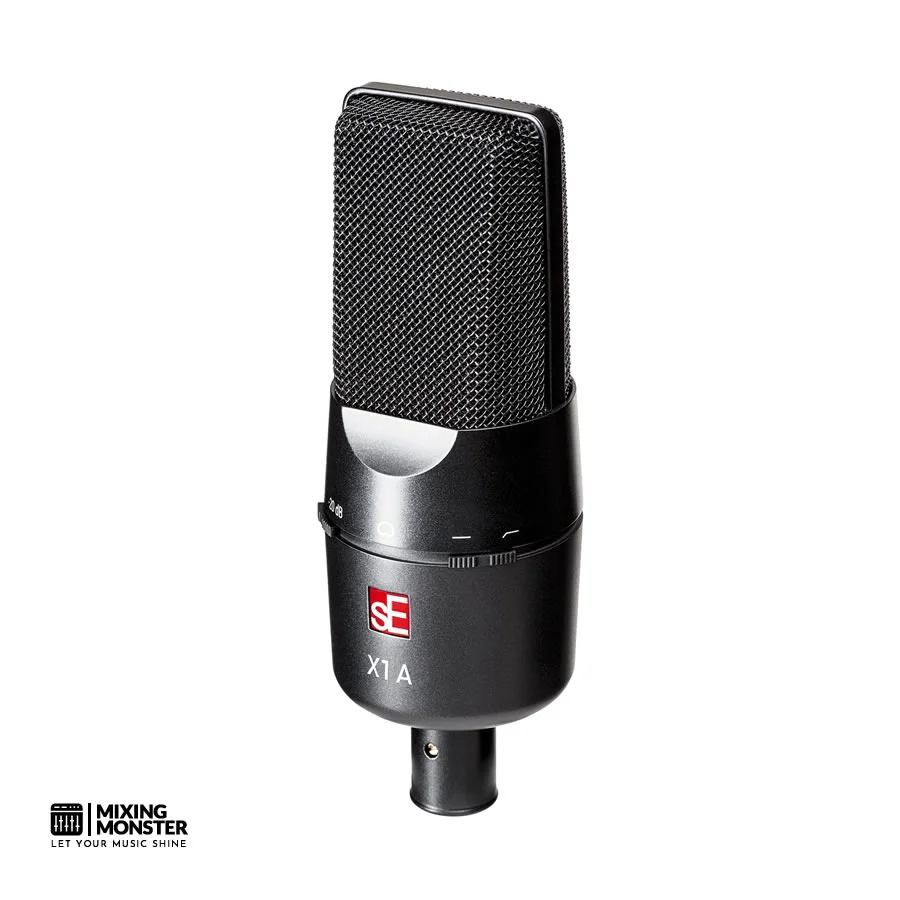
Overview:
The SE Electronics X1 A Microphone is a solid choice for those recording at home or in a project studio. Its sturdy all-metal construction reassures users it’s built to last, while the integrated windscreen is a boon for achieving clear recordings without external accessories. The redesigned acoustic elements promise a balanced sound capture, reflecting its effectiveness during the vocal sessions you just had.
Pros:
- Robust all-metal housing enhances durability
- The integrated windscreen provides clear recordings
- A newly designed acoustic capsule delivers balanced audio
Cons:
- Limited to just three reviews on Amazon
- Potential for interference without proper studio setup
- Requires 48v phantom power, which may not be available in all audio interfaces
Unique Selling Point:
The unique selling point of the SE Electronics X1 A lies in its acoustic design. The microphone’s capsule brings exceptional clarity and speed in capturing sound, making it an artfully engineered tool for precise audio reproduction.
Key Benefits:
- The all-metal housing and premium finish suggest long-term durability and reliable performance under various recording circumstances.
- The integrated windscreen is particularly beneficial for vocal work, eliminating plosives effectively without additional pop filters.
- Its complete acoustic redesign affords users a wide frequency response and quick transient handling, enhancing recordings from vocals to instruments.
Pricing:
| Average Price | ~ $90 |
Review:
The sE Electronics X1 A is an exceptional addition to any recording environment that delivers quality sound. When we tested this microphone, it impressed us with its ability to isolate the sound source and exclude background noise, thanks to its robust design.
Despite only a few reviews to back it up, more is needed to satisfy the critical ear. It’s a great contender in the battle for a clear, balanced sound at an affordable price.
Recording with it feels straightforward and unwaveringly reliable. It fits seamlessly into our existing setup, and the solid feel and acoustic refinement spoke for themselves.
In conclusion, the X1 A is an indispensable asset in our recording toolkit and could serve yours for years.
#3 Audio-Technica AT2020
Best For Home Studios Voiceovers And Project Recording
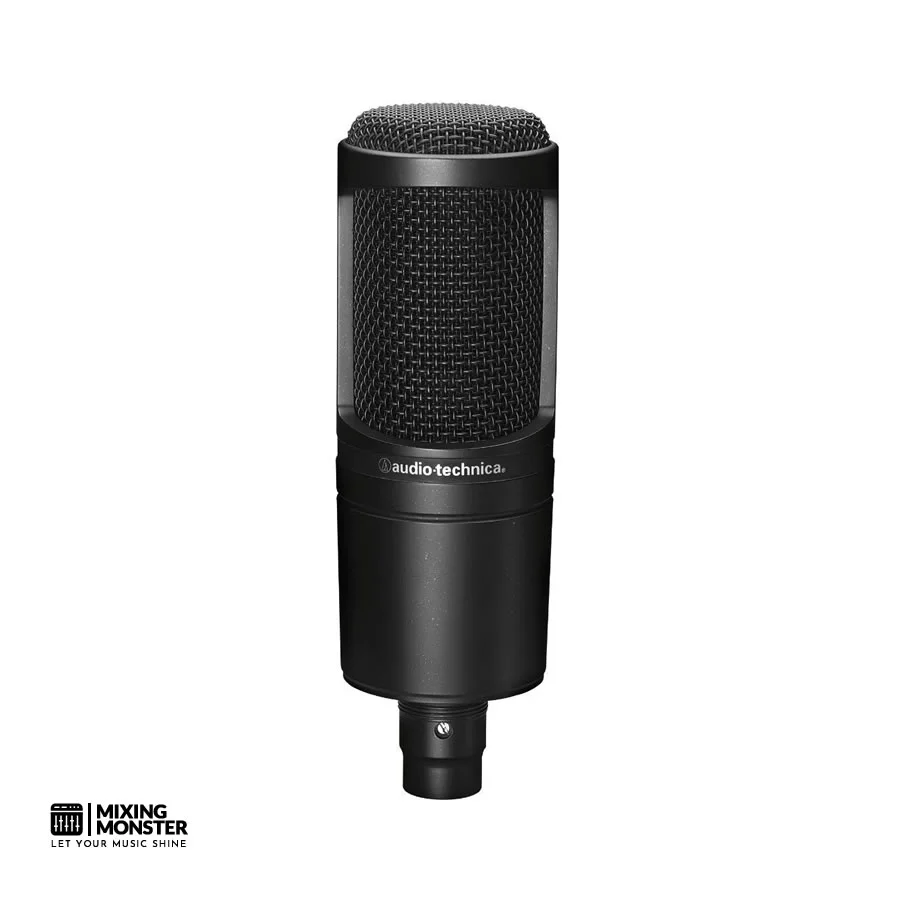
Overview:
Offering exceptional clarity and versatility, the AT2020 by Audio-Technica has carved itself a place in our studio setup. Through its superior design, this microphone captures rich, detailed sound with an ease that outshines other models in its price range. Durability meets performance here, and the AT2020’s ability to handle high SPLs means it’s as robust as it is sensitive.
Pros:
- Outstanding sound clarity
- Well-built and reliable
- Offers professional-level recording at home
Cons:
- Requires additional XLR equipment
- Not suited for untreated recording spaces
- Fixed cardioid patterns can limit flexibility
Unique Selling Point:
The AT2020‘s low-mass diaphragm delivers an extended frequency response rarely seen in mics at this price level.
Key Benefits:
- High SPL handling ensures versatility without distortion across a range of loud sources.
- Rugged construction means longevity and consistent performance.
- The cardioid pattern provides excellent source isolation, perfect for recording vocals or solo instruments.
Pricing:
| Average Price | ~ $100 |
Review:
We’ve been using the AT2020 in various projects lately and are repeatedly impressed by its performance. From detailed voice recordings to capturing the nuances of acoustic instruments, this microphone never misses a beat.
Its cardioid pattern has been a boon for our sound isolation needs, and despite its low price, the AT2020 fades into the background, allowing the recorded source to shine genuinely.
There’s no question that an XLR interface is necessary to power the mic, but the resulting sound quality has made this a non-issue for us. Occasionally, we deal with reflections when recording less-than-ideal spaces, but a few acoustic adjustments typically smooth out any concerns.
Ultimately, the AT2020 is a stellar entry point into higher-level recording. Providing impressive durability and excellent sound reproduction, it’s a sound investment for anyone serious about their audio endeavors, especially considering its humble price tag.
#4 Shure SM57-LCE
Best For Studio Recording And Live Sound

Overview:
The Shure SM57-LCE has long been held in high esteem in audio capture, and for good reason. Known for its reliability, this microphone impressively reproduces both amplified and acoustic instruments, and it’s also a staple for vocal work. When we tried it, the sound accuracy was remarkable, and the durability was a clear standout, making us feel confident this mic was built to last.
Pros:
- Excellent at capturing clear and precise sounds
- Effective background noise reduction
- Robust and can withstand regular use
Cons:
- It requires a good amount of gain, which might be an issue for some setups
- Lacks additional features found in some newer microphones
- The design is classic, but some users may prefer a modern aesthetic
Unique Selling Point:
The SM57-LCE‘s consistent performance is an actual trademark. This microphone’s ability to focus on the primary sound source while eliminating background interference helps ensure clean and professional recordings.
Key Benefits:
- Rich and detailed audio reproduction enhances both instrument and vocal recordings.
- The pneumatic shock-mount system effectively minimizes handling noise, supporting high-quality sound capture.
- The formidable construction quality lends reliability trusted by sound professionals worldwide.
Pricing:
| Average Price | ~ $110 |
Review:
We’ve had the opportunity to experience the Shure SM57-LCE firsthand, and it’s clear why this microphone is considered a studio and stage workhorse.
When recording, the sound we captured was crisp and well-defined, whether micing an acoustic guitar or capturing the nuanced variations of a vocal performance. The cardioid pattern did a superb job focusing on the source, which made a noticeable difference in sound isolation.
Handling the mic, we appreciated the rugged design. Even when moving it between different instruments or adjusting it on the fly, there was no unwanted noise, thanks to the shock-mount system. It’s a mic that could take the heavy use of touring or rigorous recording sessions and still perform impeccably.
While this microphone might not offer the bells and whistles of newer models, such as built-in digital converters or extended frequency ranges, its design proves that it doesn’t need them to deliver quality sound.
In sum, the Shure SM57-LCE confirms its legendary status with every use. Whether you’re fitting out a home studio or gearing up for a series of live performances, this microphone holds its own, delivering quality that exceeds its price point. It’s clear why it has become an industry standard and deserves a place in any sound engineer’s kit.
#5 Heil Sound PR22-UT
Best For Live Vocalists And Recording Artists
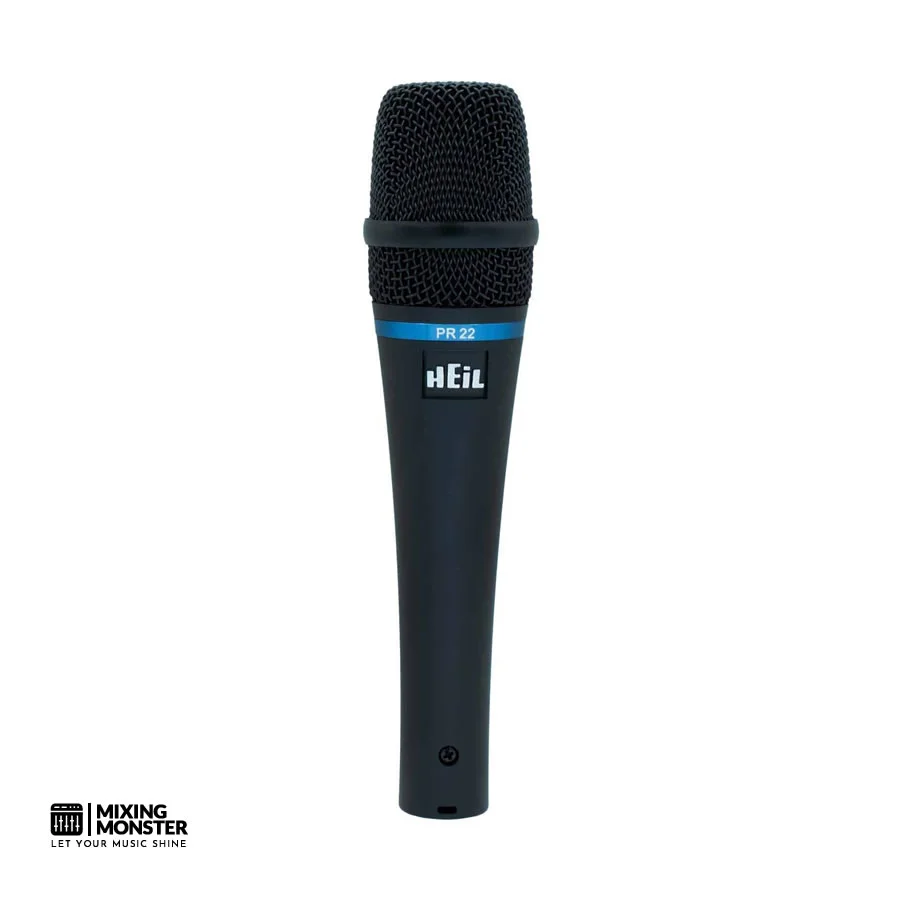
Overview:
The Heil Sound PR22-UT is a solid, robust, entry-level studio microphone that is excellent for vocal recordings and live performances.
Pros:
- Exceptional sound clarity and quality
- Durable build with internal shock mount
- Reduced handling noise
Cons:
- Requires proximity for optimal pickup
- It might emphasize low frequencies on specific systems
- No included XLR cable
Unique Selling Point:
The Heil Sound PR22-UT sets itself apart with its internal shock mount design, significantly curtailing handling noise. This feature makes it a formidable utility microphone in various settings.
Key Benefits:
- Superior sound clarity enhances both live performances and recording sessions.
- Robust construction endows it with longevity, suitable for the rigors of touring and regular use.
- Effective handling noise reduction allows for cleaner audio capture, ensuring a professional experience.
Pricing:
| Average Price | ~ $120 |
Review:
We’ve spent substantial time with the Heil Sound PR22-UT; this mic is a workhorse. From the first soundcheck, its clarity distinguishes it from many others we’ve encountered. Vocals come through with precision, and the microphone’s cardioid pattern does an excellent job of rejecting off-axis sound.
Handling the mic, we appreciated the internal design that dampens noise – a subtle but crucial detail for live performances. Durability confirmed our trust in its ability to endure the demanding environments of gigging and touring, which can be harsh on gear.
However, we noticed that to get the best out of this mic, you’ve got to stay close; otherwise, the volume drops significantly. And while the sound is generally balanced, there were times when the low frequencies seemed more prominent, depending on the system we used. There is nothing that a little EQ couldn’t fix, but it is worth mentioning.
One thing to remember is that you’ll need an XLR cable since one is omitted. Despite that, the carrying case and windscreen add value.
After extensive use, our affection for the PR22-UT has only grown. It’s not just about the sound quality; it’s also about how it feels reliable and ready for any challenge.
Whether you’re right on it delivering intense vocals or capturing the nuance of acoustic instruments, this microphone impresses. If you need a dynamic, versatile option in your mic locker, we highly recommend the PR22-UT.
Best Midrange Studio Microphones
#6 Shure BETA 58A
Best For Live Vocal Performances And Studio Vocal Sessions
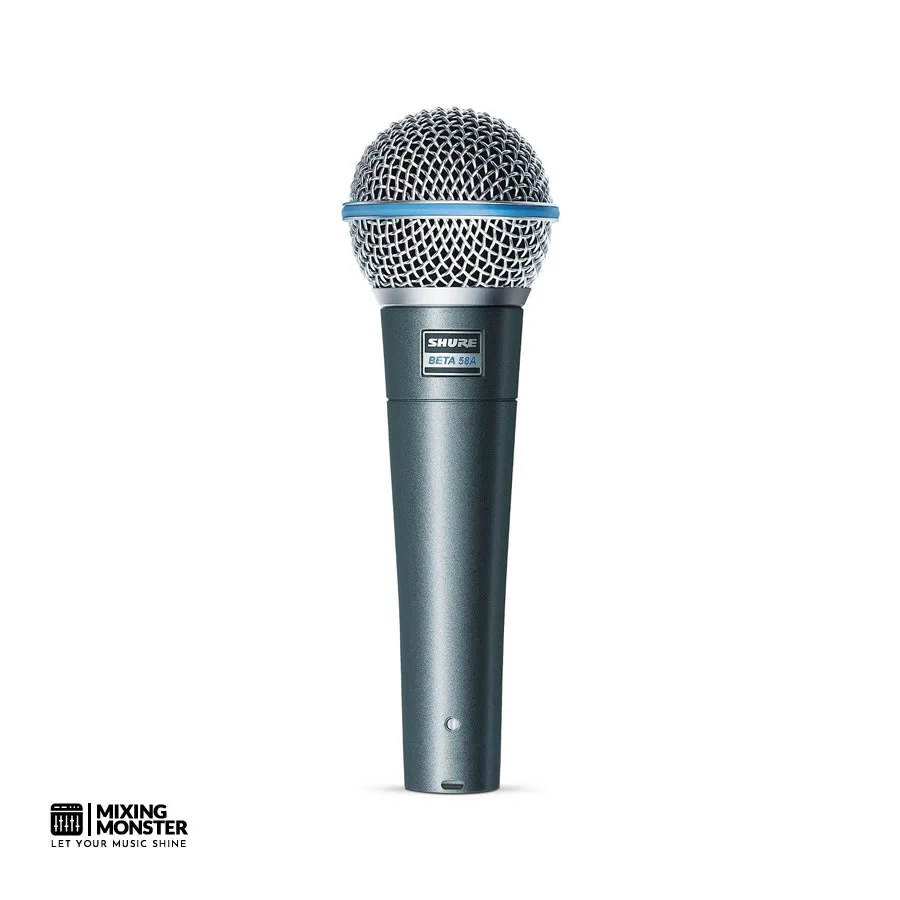
Overview:
Kicking off a live set with the Shure BETA 58A in hand guarantees that vocals will pierce through any mix with definition and warmth. During recording sessions, it’s adept at highlighting nuances in a singer’s voice, while in a live setting, the crowd hears every word, regardless of backing instrumentals.
Pros:
- Remarkable clarity and range for vocal projection
- Highly durable, handles rough use well
- Superior noise rejection for stage environments
Cons:
- Not the most budget-friendly option
- Requires a skilled technique to maximize sound quality
- Perhaps too sensitive for untrained voices
Unique Selling Point:
Its hardiness is apparent; the Shure BETA 58A feels solid in your grasp and unfazed by the jostles and bumps of heavy studio use. This mic cuts through ambient noise, proving its worth on crowded stages.
Key Benefits:
- Robustness in both live vocal performances and recording sessions
- Pneumatic shock mount system reducing handling noise
- The iconic standard of vocal recordings microphones.
Pricing:
| Average Price | ~ $170 |
Review:
From our recent sessions with the Shure BETA 58A Vocal Microphone, its reputation precedes it. It shines in its ability to bring vocal performances to life with crispness and vibrancy that rival even high-end studio mics.
When testing it, the BETA 58A impressed us with its handling of high sound pressure levels. Those belted notes came through clear without distortion – a testament to its high output. Careful crafting of its frequency response enhances presence and mitigates boominess, showcasing Shure’s attention to detail.
Lastly, it’s reassuringly consistent. Through dozens of gigs, its performance never wavered, thanks to the uniform super cardioid pattern.
However, the Shure BETA 58A has its quirks. Given its superior design, it’s not unexpected that it sits at a higher price point. New users may need time to adapt to its sensitivity; this microphone does not forgive sloppy techniques. Less experienced vocalists need help to control the powerful pickup pattern.
By all indicators, the Shure BETA 58A doubles down on robustness and sound quality. It endures the rigors of touring with almost no sign of wear. Its pneumatic shock mount system is a boon, reducing handling noise to nearly nil during energetic performances. This microphone is a road warrior with a steel mesh grille that can take a beating.
In conclusion, the BETA 58A‘s capabilities are a testament to Shure’s legacy in providing outstanding microphones that stand the test of time and use.
#7 Shure 55SH Series II Retro
Best For Performers And Broadcasters Seeking Vintage Style With Modern Quality
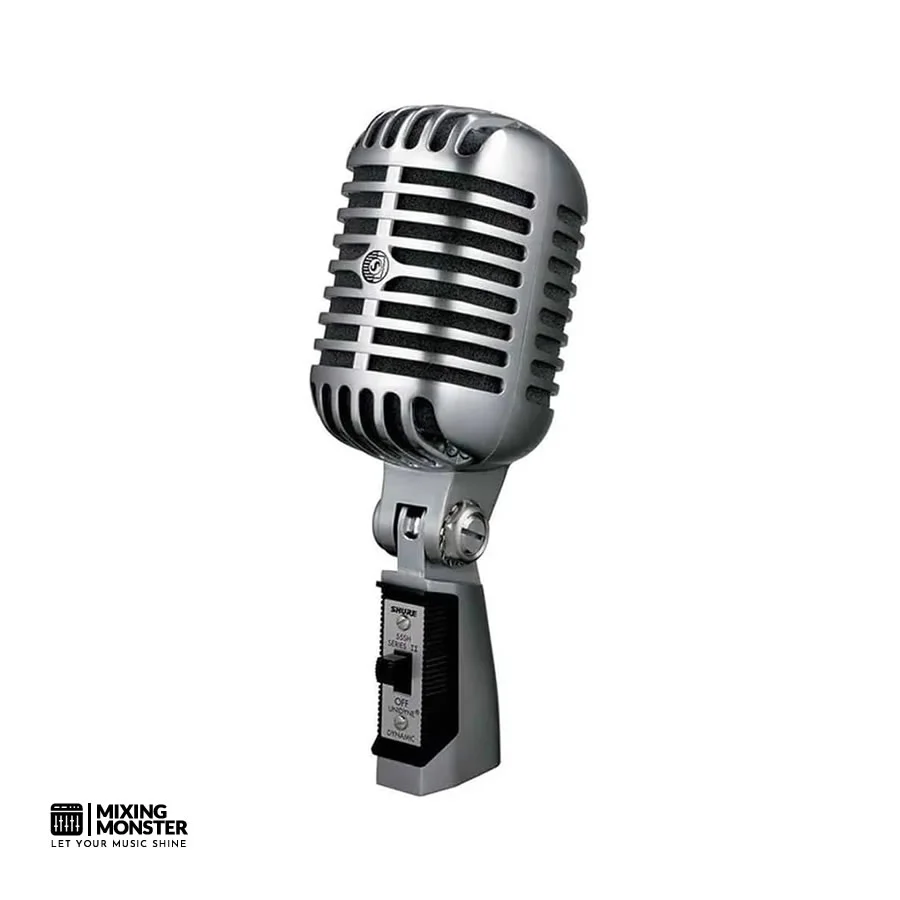
Overview:
If you’re looking for a microphone that delivers a fusion of vintage aesthetic and contemporary performance, the Shure 55SH Series II is an excellent contender. Its retro design is visually stunning and ergonomically practical, securing its spot as a centerpiece on stage or in the studio. We’ve found its sound quality to be warm and accurate, capturing the nuances of vocal performances with finesse. The construction is solid, imbuing a sense of reliability that’s hard to match.
Pros:
- Nostalgic design that turns heads
- Robust construction with exceptional sound quality
- Impressive feedback rejection in live settings
Cons:
- Size and weight may be cumbersome for some
- Not suited for all recording scenarios
- Higher price point compared to some modern alternatives
Unique Selling Point:
A hallmark of the Shure 55SH Series II lies in its extraordinary blend of classic appeal and modern functionality. This microphone isn’t just a piece of equipment; it’s a statement piece we’ve seen resonate with audiences and performers alike. The attention to detail in its construction and sonic capabilities sets it apart.
Key Benefits:
- The eye-catching design enhances stage presence and instills a strong sense of nostalgia.
- The cardioid pickup pattern offers excellent sound isolation even amid noisy environments.
- Durability that ensures this microphone withstands the rigors of consistent use.
Pricing:
| Average Price | ~ $200 |
Review:
From the moment we laid hands on the Shure 55SH Series II, it was evident that this wasn’t an ordinary microphone. Its weight and metal feel exuded a level of craftsmanship we rarely encounter. Vocals recorded with it sound full-bodied and crisp, largely thanks to the tuned frequency response. The cardioid pattern effectively keeps feedback at bay, which we find indispensable for live performances.
This mic has proven reliable in diverse settings, from intimate studio recording sessions to lively music gigs. Aesthetically, it’s a home run, often sparking conversations and adding a touch of class to any setup. On a practical note, we appreciate the internal shock mount—a detail that dampens unwanted noise and vibrations.
Priced at a premium, the Shure 55SH Series II is an investment in quality. While not the go-to for all recording applications, when it’s suited to the task, it shines like no other, both visually and audibly. Anyone who values design and durability as much as sonic character will appreciate what this mic offers.
Our experience assures us that the Shure 55SH Series II is more than a pretty face. It’s a robust, reliable, and outstanding-sounding piece of equipment that would make a valuable addition to any audio arsenal. Whether it’s proving its mettle on stage or bringing a touch of vintage flair to the studio, Shure has struck a chord with this iconic offering.
#8 Sennheiser E906
Best For Guitar Amps And Percussion
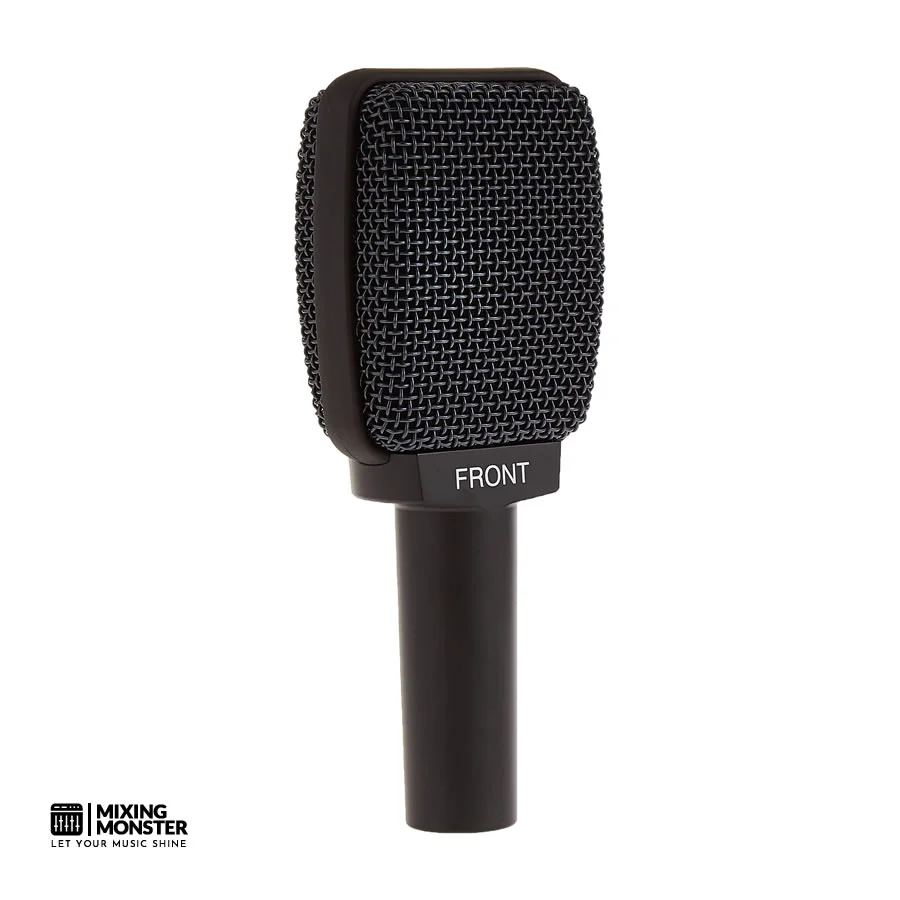
Overview:
We recently tested the Sennheiser E906 and are pure satisfied. This dynamic microphone exhibits a delicate balance between capturing guitar amps’ raw energy and percussion instruments’ subtle nuances. Its flat shape and super-cardioid pattern make it a favorite in snug studio spaces.
Pros:
- Handles high SPL with ease, capturing loud sources without distortion
- Highly adaptable with switchable sound character
- Enduring design with a reinforced metal body
Cons:
- It might be less ideal for capturing a more expansive ambient sound due to the super-cardioid pickup pattern
- Bulkier compared to some pencil condensers when miking drums
- There is a slight learning curve to finding the perfect mic placement for the best sound
Unique Selling Point:
The Sennheiser E906‘s unique flat design allows it to slide into tight spaces with ease. It’s a real game-changer, particularly when miking drum kits or tucking neatly against a guitar cab.
Key Benefits:
- Its laterally mounted capsule delivers focused audio capture, recording every strum and hit.
- The three-position switchable sound feature offers flexibility. It allows users to adjust between bright, moderate, or dark tones to suit varied recording needs.
- The super-cardioid pickup pattern isolates the sound source excellently, minimizing bleeding from other instruments.
Pricing:
| Average Price | ~ $200 |
Review:
When we took the Sennheiser E906 into our hands, we knew it was built to last. The robust construction screams ‘road-ready,’ and in the studio, it performed flawlessly. Positioning it was a breeze, and it cozied up against our guitar amps with no fuss.
Not one to shy away from loud sources, this mic captured every detail without a hint of harshness. Its tonal flexibility impressed us; each switch position brought a new character to the table, suiting various instruments and styles.
Granted, it focuses on the source quite tightly, which is perfect for isolating sounds, but there are other choices for a roomy ambiance. The efficiency of this mic amazed us during a recent recording session with a punchy snare and a growling guitar cabinet, delivering recordings that barely needed EQ.
The Sennheiser E906 has secured its spot in our studio arsenal. Whether you’re tracking a demo or laying down tracks for a total album production, it’s a real asset.
#9 RØDE NT1 5th Generation
Best For Professional-Grade Home Recording
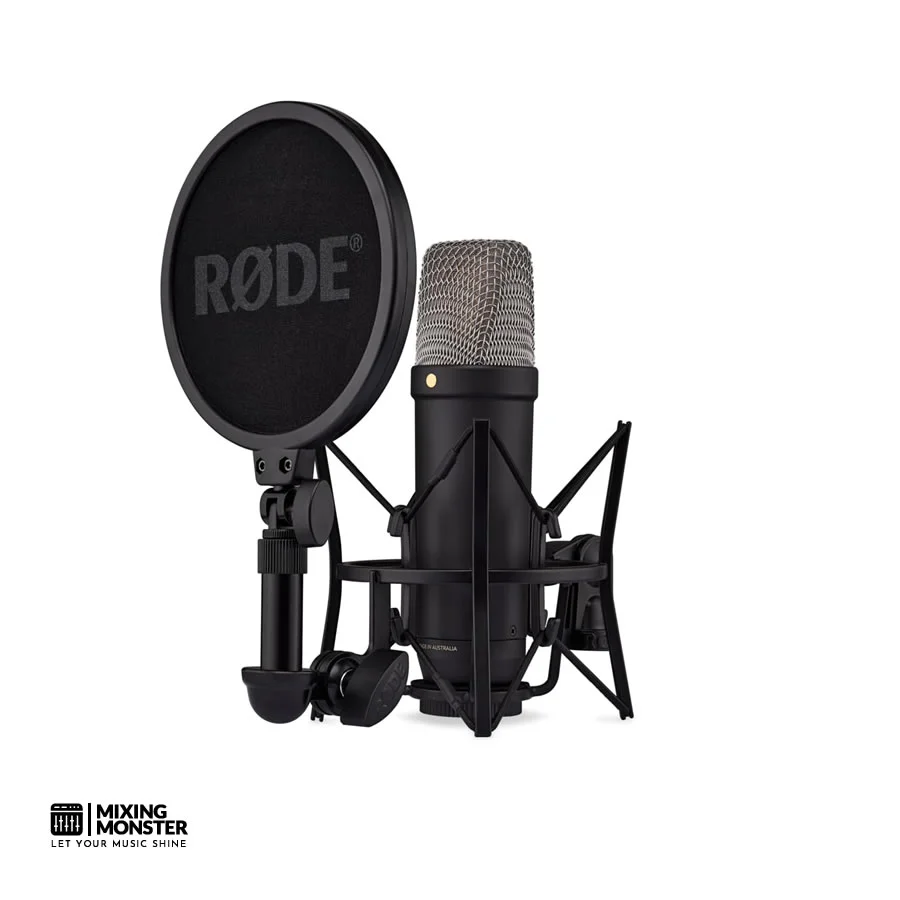
Overview:
The RØDE NT1 5th Generation Microphone is a beacon of clarity in the home studio mic market. Striking a balance between high-end features and user-friendly functionality, it’s designed for those who demand professional quality without the complexity. The seamless blend of XLR and USB outputs ensures versatility across various recording environments, making it an ideal choice for vocalists, podcasters, and instrumentalists.
Pros:
- Dual XLR and USB connectivity simplifies recording setups
- An exceptionally low self-noise level allows for pristine audio capture
- Robust build quality that withstands the demands of frequent use
Cons:
- The premium feature set might be more than what’s necessary for beginners
- Requires additional investment in a stand or arm for optimal placement
- Potential overkill for those not requiring high-resolution recording capabilities
Unique Selling Point:
The NT1 5th Gen‘s standout feature is its Revolutionary Preamp technology and 32-bit float digital recording. It delivers an unmatched audio reproduction quality that satisfies even the most meticulous recording professionals.
Key Benefits:
- The ultra-low-noise performance guarantees that recordings are free of unwanted background hiss, focusing entirely on the intended sound source.
- The microphone’s high-grade aluminum construction ensures durability, ready to tackle session after session without faltering.
- With USB and XLR output options, users can record directly to their computer or through traditional mixer setups, granting unmatched flexibility.
Pricing:
| Average Price | ~ $200 |
Review:
As we unpacked the RØDE NT1 5th Gen, its sleek black finish and sturdy build urged us to put it through its paces immediately. The setup was a breeze, accommodating our conventional mixing board via XLR and a simple USB connection for quick computer-based projects.
During our session, the microphone’s high SPL handling allowed us to capture everything from hushed vocals to roaring guitar amps with equal fidelity. The high-resolution A/D conversion and 32-bit float recording translated into recordings that were crisp, clear, and true to the original performance.
The near-absence of background noise was equally impressive, a testament to the NT1’s ultra-low-noise design. With the supplied pop filter and shock mount, our takes were polished and plosive-free, minimizing post-production work. Despite its pro-level features, we found the RØDE NT1 incredibly straightforward to use – it truly felt like a professional studio tool within the comfort of our own recording space.
While its price point may initially give beginners pause, for those serious about their sound, this microphone is a sound investment that will satisfy for years to come. Having used it extensively, we feel a profound confidence in recommending the RØDE NT1 5th Gen to all levels of audio enthusiasts – its performance consistently inspires creativity. This microphone is a standout tool and a centerpiece in any recording setup.
#10 Warm Audio WA-47jr
Best For Versatile Recording And Sound Faithful To The Classic ’47 Mic
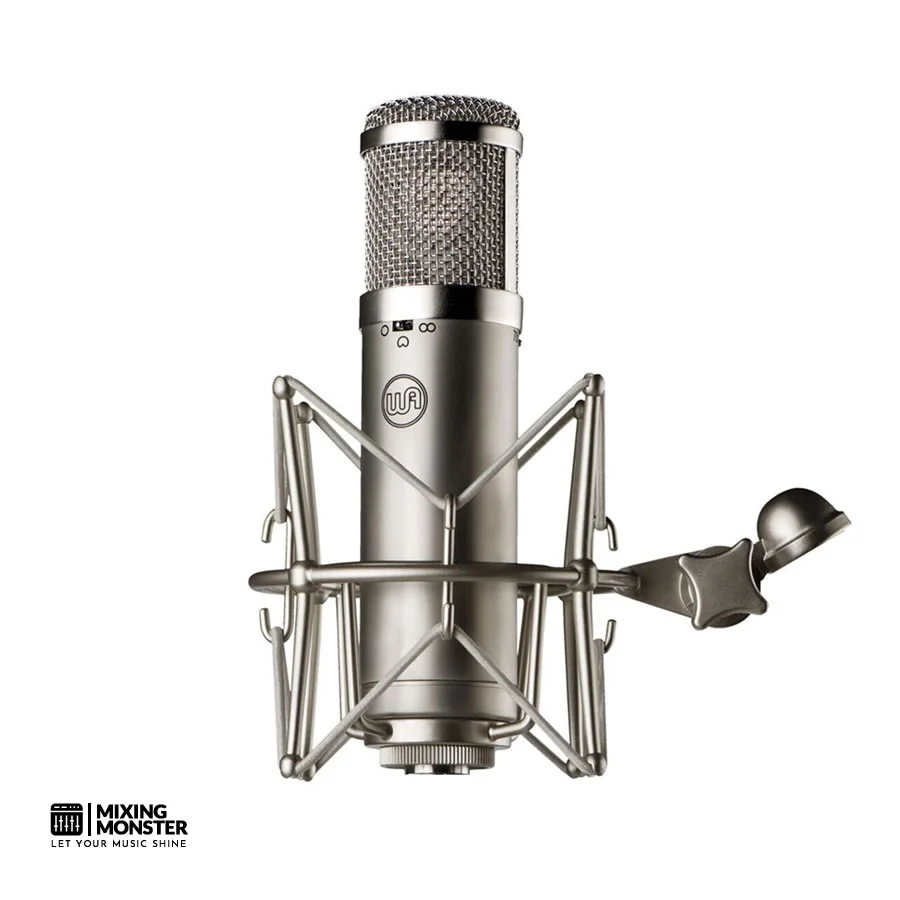
Overview:
Recording with the WA-47jr bolsters confidence, as the audio captured will likely need minimal post-processing, if any. The sound is clear and true, with a slight absence of that harmonic distortion some might be craving from a transformer-based mic, but not enough to overshadow its overall quality.
Pros:
- Excellent performance across multiple sound sources
- Three selectable polar patterns offer adaptability
- High-quality sound at a reasonable price point
Cons:
- The lack of a transformer may affect harmonic character for some users
- Shock mount build could be improved for better support
- Some users might prefer a mic with an integrated pad and HPF settings
Unique Selling Point:
The Warm Audio WA-47jr excels for those pursuing classic microphone characters without the steep price. Do you have a dynamic range of sounds to capture? This mic is a steadfast companion, ensuring every subtle nuance is caught.
Key Benefits:
- The ultra-low-noise performance guarantees that recordings are free of unwanted background hiss, focusing entirely on the intended sound source.
- The microphone’s high-grade aluminum construction ensures durability, ready to tackle session after session without faltering.
- With USB and XLR output options, users can record directly to their computer or through traditional mixer setups, granting unmatched flexibility.
Pricing:
| Average Price | ~ $270 |
Review:
We just finished recording with the WA-47jr, and the results brought to light the impressive versatility of this microphone. Its adaptability to various recording scenarios was immediately evident as it precisely captured vocals and instruments. Its trio of polar patterns—cardioid, omnidirectional, and figure-eight—open up many possibilities, making it a suitable choice for nearly any studio situation.
Despite its transformerless design, the WA-47jr preserved the spirit of the original ’47—a legendary element in the recording industry. The affordable price is also hard to overlook, especially considering the higher-end mics’ sound quality. When it came to its build, the robust mic held its own, but a sturdier shock mount would provide better support for such a quality piece of equipment.
The sound this mic offers straight out of the box is impressive. Upon unpacking, one will notice the attention to detail Warm Audio bestows upon the WA-47jr, from its sleek design to its solid construction—except the shock mount, which may warrant an aftermarket replacement for added security during intense sessions.
Lastly, considering the competitive market and the stellar performance of the WA-47jr, one can appreciate the value this microphone brings to the table. It’s a choice that won’t disappoint, as the recordings made with it continue to echo its quality.
Best High-End Studio Microphones
#11 Shure SM7B
Best For Professional Studio Recording, Streaming And Broadcasting
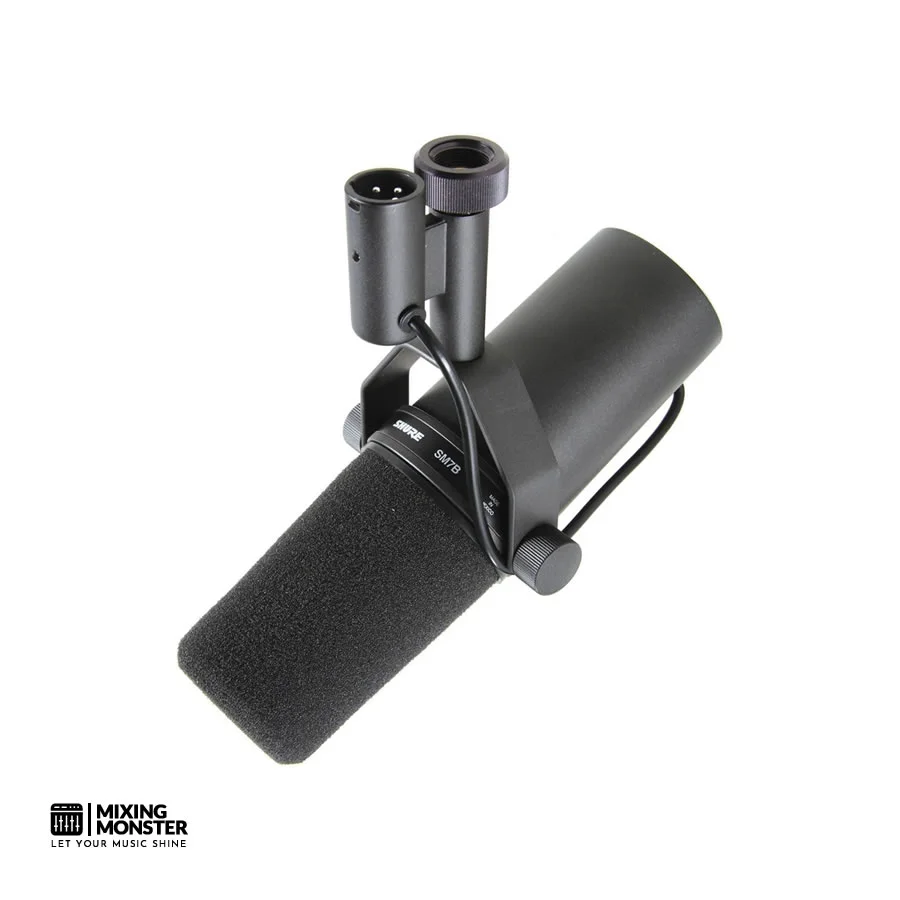
Overview:
The Shure SM7B microphone has become our go-to solution in professional recording and broadcast environments. Our experience with the microphone has demonstrated its reliability and consistent performance, capturing vocals and instruments with clarity and precision. The physical design adds a sleek, professional look to our studio, and the included windscreens provide versatility for different recording situations.
Pros:
- Exceptional vocal clarity and natural sound reproduction
- Highly effective at rejecting electromagnetic interference
- Rugged construction with an improved mounting bracket
Cons:
- It may require a substantial amount of gain from preamps
- Its weight and size demand a sturdy stand or boom arm
- Higher price point compared to entry-level microphones
Unique Selling Point:
The Shure SM7B distinguishes itself with its advanced electromagnetic shielding. We’ve noticed this makes a significant difference in maintaining the integrity of audio capture in an environment saturated with electronic devices. Its reliable performance under various conditions truly sets it apart.
Key Benefits:
- The flat, wide-range frequency response produces clean and natural audio—enhancing music recordings and spoken word.
- The cardioid polar pattern directly focuses on the sound source before the microphone, minimizing unwanted background noise.
- Durability and longevity are ensured with the SM7B’s high-quality construction, indicative of Shure’s professional standards.
Pricing:
| Average Price | ~ $315 |
Review:
Upon first use, the Shure SM7B immediately proved why it’s a favorite among audio professionals. Our sessions with the microphone highlighted its ability to produce a warm, rich sound without the need for extensive post-processing.
Despite needing a preamp with enough gain, the resulting audio quality justifies the setup. The microphone’s performance remained consistent across various applications, from capturing the nuanced vocals of a singer to recording the dynamic range of a podcast host.
The Shure SM7B has been an excellent tool in streaming activities, contributing to a professional-level broadcast. The microphone captured sound with remarkable fidelity, whether for a music session or a dialogue-heavy stream. It has maintained its quality through long-term use without any signs of degradation, reinforcing the investment value.
Toward the end of each session, we appreciate the microphone’s sleek design and steady presence in our studio. The SM7B‘s contribution to our work can’t be overstated — it’s a cornerstone of quality audio capture, and we consider it integral to our setup. Closing each recording, it’s clear why this microphone enjoys such widespread acclaim.
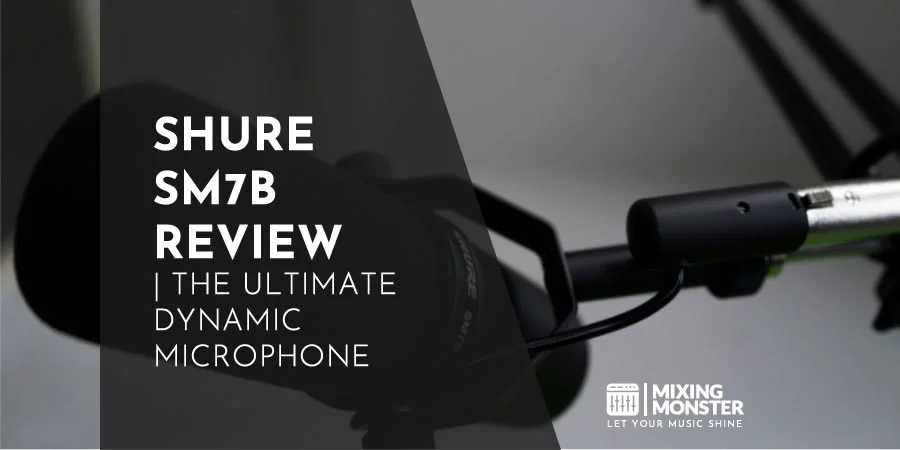
#12 Beyerdynamic M 160
Best For Studio Recording And Acoustic Instruments
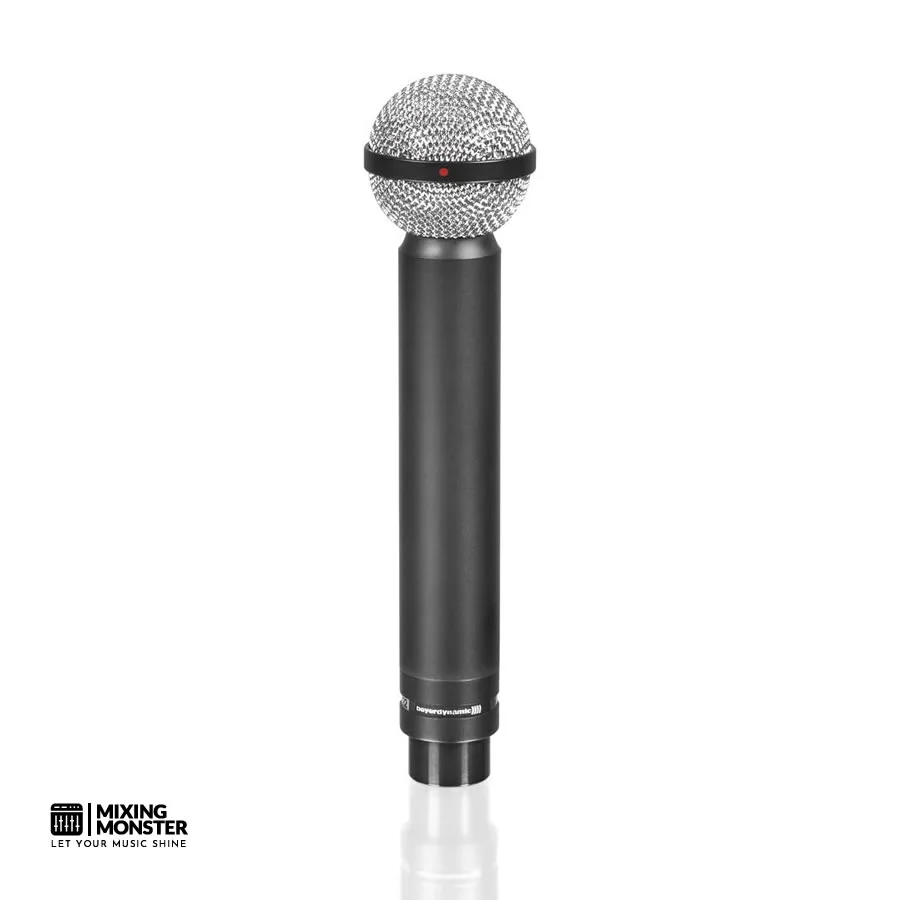
Overview:
Whether you’re an audiophile or a seasoned audio engineer, the Beyerdynamic M 160 is a stellar choice that delivers pristine sound quality and unparalleled durability.
Pros:
- Remarkable clarity and warmth for acoustic instruments
- Durable build to withstand regular use
- Exceptional side noise rejection for focused recordings
Cons:
- Higher cost compared to some entry-level options
- It may require a quality preamp to achieve the best results
- Lower output level necessitates proper gain staging
Unique Selling Point:
What sets the Beyerdynamic M 160 apart is its hypercardioid double ribbon design. This unique feature provides unparalleled precision and detail in capturing sound, making it a go-to microphone for critical studio work.
Key Benefits:
- Exceptional hypercardioid polar pattern offers focused capture and minimizes room reflections.
- The double ribbon element produces a natural, smooth sound signature that adds character to recordings.
- The compact size and discrete profile allow a hidden setup in any recording environment.
Pricing:
| Average Price | ~ $800 |
Review:
After testing the Beyerdynamic M 160, we’ve concluded it’s quite the workhorse in a studio setting. Its design oozes professionalism, and it feels robust enough to handle the rigors of daily use. Our sessions revealed its particular prowess in dealing with acoustic instruments, where its characteristics brought a new layer of depth and realism to the recordings.
The handling noise is minimal, which is a blessing in a dynamic performance. However, this is a mic you’d grab with proper preparation; its lower sensitivity and output level require pairing it with a quality preamp, an aspect to consider when budgeting.
Recording with the M160 is revealing. The soundstage feels wide, and the pin-point accuracy in instrument separation is impressive. Vocals recorded with this mic sit well in a mix, requiring minimal post-processing to stand out, which is a testament to its natural sound reproduction.
We ended the review session appreciating the M 160’s quiet operation and the subtle way it enhances the source material. While it might dent your pocket more than other mics, the investment is justified by the superior sound quality and the professional detail it brings to every recording. Beyerdynamic’s craftsmanship shines through with the M 160, strengthening its claim as a top-notch studio microphone.
#13 AKG C414 XLII
Best For Professional Studios And Discerning Audiophiles
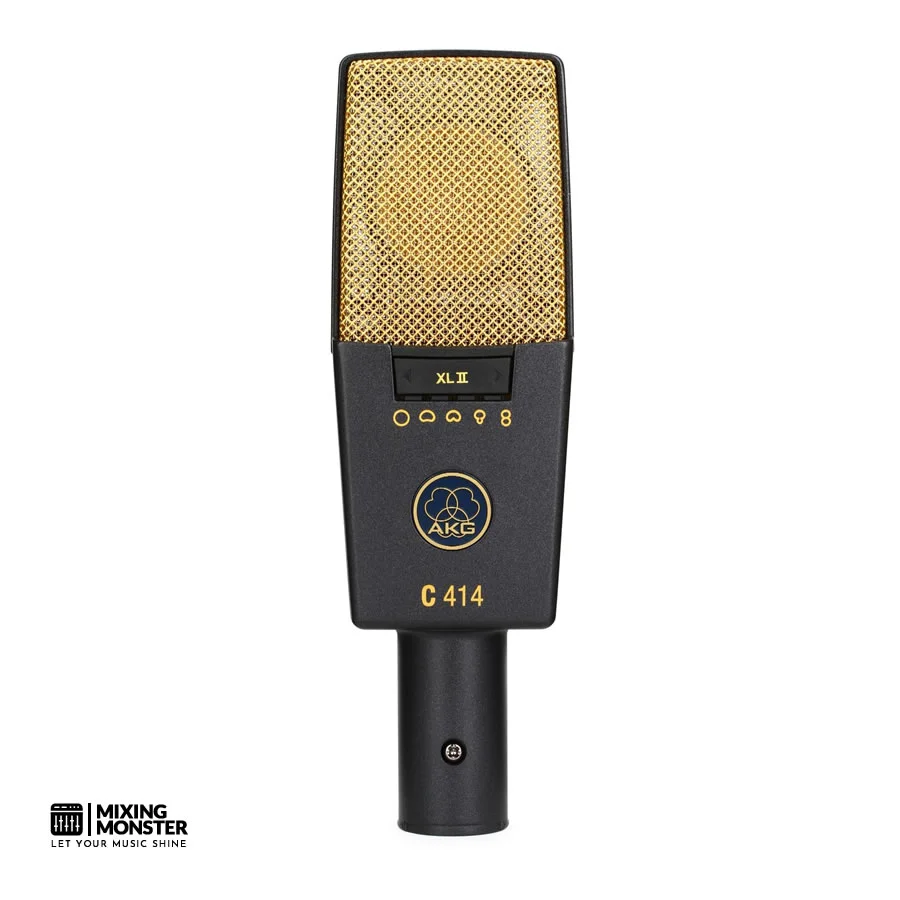
Overview:
The AKG C414 XLII is an exceptional choice for those seeking a top-tier studio microphone, especially in professional settings.
Pros:
- Versatile polar patterns offer extensive recording flexibility
- Provides a richness and clarity of sound that enhances vocal and instrumental tracks
- Solid build quality paired with user-friendly features for a hassle-free recording experience
Cons:
- A high price point may not suit all budgets
- A slight presence boost might require adjustment for specific recording applications
- LED peak indicator could be more detailed for precise monitoring
Unique Selling Point:
Capturing studio-quality sound requires a sophisticated microphone, and in our hands, the AKG C414 XLII feels like a tool crafted for perfection. Its ability to switch across different polar patterns provides unparalleled adaptability, whether recording a nuanced vocal, capturing the dynamics of a live orchestra, or sitting it overheads for drum sessions. Robust and elegantly designed, this microphone inspires confidence when it leaves its premium carrying case.
Key Benefits:
- The AKG C414 XLII offers nine polar patterns, including cardioid, wide cardioid, hypercardioid, omnidirectional, and figure-8. This versatility allows for extensive recording flexibility, accommodating everything from vocals to various instruments, making it an ideal choice for various studio applications.
- The microphone is known for enhancing vocal and instrumental tracks with its rich, detailed sound. The C414 XLII captures the nuances of performances, providing a flattering effect on the human voice and accurately representing instruments, which is crucial for high-quality recordings.
- The AKG C414 XLII is about superior sound and boasts a solid build quality that ensures durability and longevity. This, paired with user-friendly features like switchable attenuation pads and bass-cut filters, ensures a hassle-free recording experience, allowing artists and engineers to focus on the creative process.
Pricing:
| Average Price | ~ $800 |
Review:
The AKG C414 XLII illuminates the soundscape with a clarity and sonic presence reminiscent of the legendary AKG C12. While its upfront sound signature ideally suits lead vocals and solo instruments through the mix, this same characteristic necessitates some mixing finesse when dealing with complex audio sources. Nevertheless, we appreciate the opportunity to sculpt sound with such precision.
Navigating the features feels second nature, with switchable attenuation levels safeguarding against distortion during high-SPL scenarios. Plus, having bass-cut filters at our fingertips does wonders to mitigate unwelcome noise. The sleek design and sturdy shock mount emphasize the attention to detail AKG Pro Audio has invested. Although learning the intricacies of its sound profile takes time, we’re continually impressed by the richness it adds to recordings.
Fulfilling the needs of professional studios and discerning audiophiles is challenging, yet the AKG C414 XLII steps up to the challenge. It’s evident in every recording – from the warmth it brings to a gentle acoustic guitar piece to the vigor captured from a soulful vocal performance. Handling the microphone imparts a sense of reliability and excellence; it’s an investment that pays dividends in enhancing our recording capabilities.
For creatives who are serious about their sound, the AKG C414 XLII’s price reflects its premium status in studio microphones. At approximately $1000, this gear targets those who understand the worth of stellar audio capture and seek the elite tools to achieve it. Balancing cost against the professional-grade results it delivers, the AKG C414 XLII asserts its value proposition confidently.
Across numerous sessions, we’ve come to see the AKG C414 XLII as a cornerstone of our studio. It’s a microphone that doesn’t just record sound but elevates it, whether working with whisper-soft vocals or the roaring fortissimo of brass instruments. Its performance consistency is a testament to AKG’s engineering, and its durability implies it’s ready for years of service.
As we lay down tracks and mix them perfectly, the AKG C414 XLII is a reliable partner, bringing audio visions to life with expert precision. We’re not simply using a microphone; we’re wielding an instrument that captures the nuances of sound with an almost tangible depth and texture.
#14 Neumann TLM 103
Best Overall Professional Studio Quality Microphone
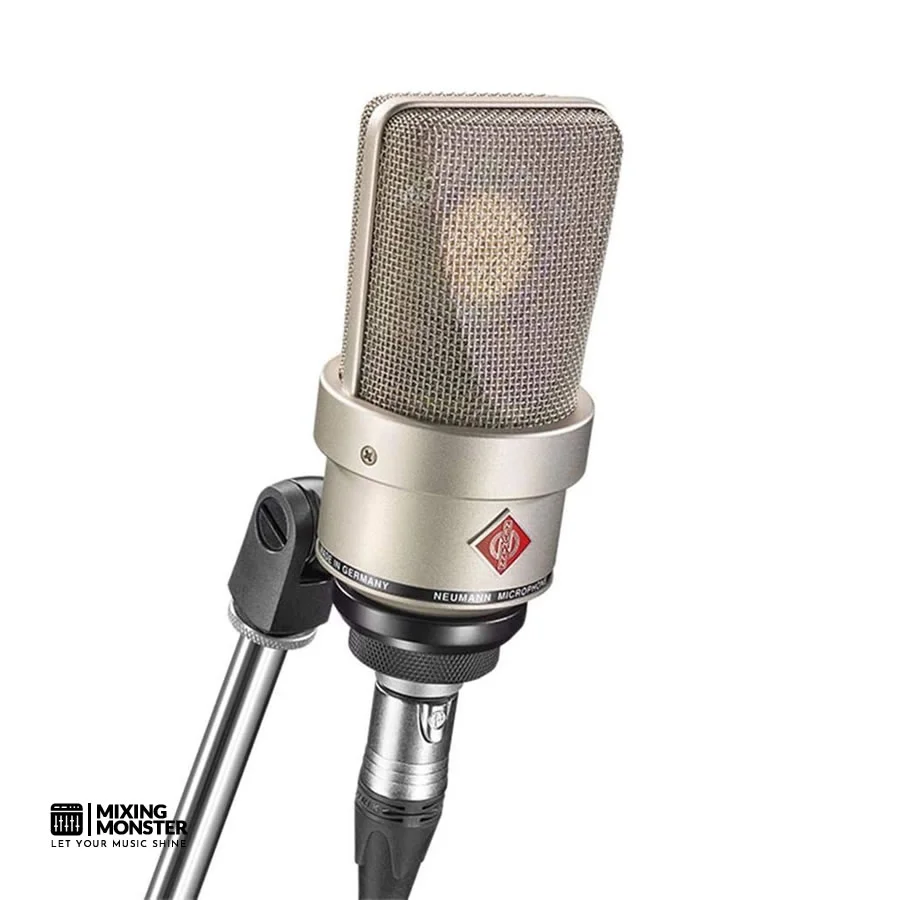
Overview:
If you’re after that Neumann pedigree to elevate your recordings, the TLM 103 could be an astute choice. Housed in a sleek body, its clear, robust sound captures the subtle nuances of vocals and instruments, making it a favorite in home studios and professional setups. Its performance consistently impresses us even in comparison to higher-priced mics.
Pros:
- Exceptionally clear audio capture
- Minimal self-noise enhances recording purity
- Sturdy design that lasts
Cons:
- Requires a separate shock mount purchase
- Higher cost compared to entry-level options
- Limited to the cardioid polar pattern
Unique Selling Point:
The Neumann TLM 103‘s large-diaphragm design and transformerless technology set it apart. This pairing gives it a distinct, pristine sound and flexibility respected among audio professionals.
Key Benefits:
- The precise sound capture enhances professional production, making it a formidable tool for vocalists and voiceover artists.
- Even the subtlest details are preserved with low noise levels, suiting nuanced acoustic sessions.
- The solid build quality brings lasting reliability, essential for regular studio use.
Pricing:
| Average Price | ~ $900 |
Review:
Using the Neumann TLM 103 confirms its stature as a top-tier microphone. It exudes the quality expected from Neumann. In sessions, it exhibited an impressive ability to capture vocal detail without the usual fuss about background noise. While testing with acoustic instruments, the TLM 103 rendered every strum and pluck remarkably clear.
However, to unleash its full potential, purchasing a shock mount separately is advisable for mitigating mechanical noise. Considering its price bracket, we had hoped it would come with one. Nonetheless, the TLM 103 embodies a compelling option for those committed to sound quality and durability.
Constant handling and setup changes haven’t fazed this microphone. It’s built like a tank, an aspect we’ve come to appreciate deeply. On the whole, the TLM 103 merits consideration from anyone who is serious about its audio production.
Despite some drawbacks, its professional-grade sound captivation makes it a perfect addition to any studio.
#15 Neumann U 87 Ai
Best For Studio Recording Enthusiasts And Collectors
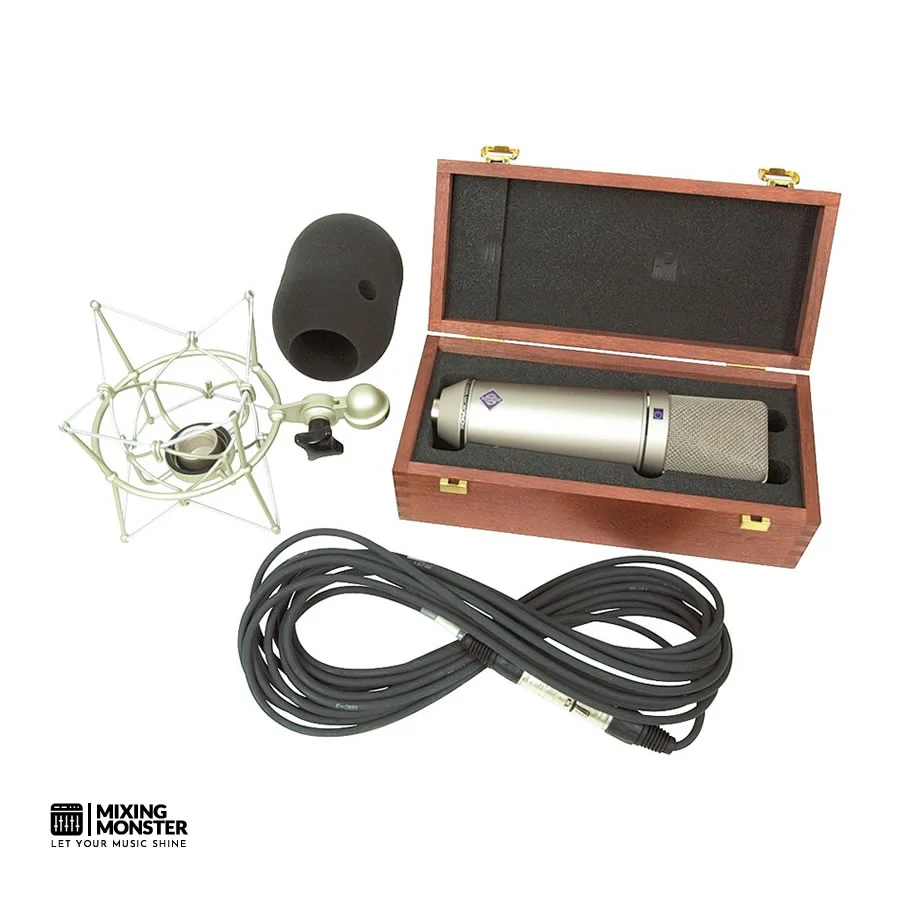
Overview:
We’ve worked with the Neumann U 87 Ai Microphone as sound experts. Across multiple sessions, it stands out for its precision and reliability. Its enduring presence in studios worldwide isn’t by chance; its performance and durability make it a premier choice for professionals who demand nothing but the best.
Pros:
- Exceptional sound quality with a warm, balanced tone
- Versatile with three selectable directional patterns
- It has an iconic design with a solid build and a shock mount.
Cons:
- Prohibitively expensive for amateurs or home studios
- Requires phantom power, which may be an extra step for some setups
- Some may find the sound too specific for certain applications
Unique Selling Point:
The Neumann U 87 Ai‘s unique selling point is its rich heritage, which combines technical innovation with unmatched audio quality. A perennial favorite among audio professionals, this microphone delivers a consistently superior performance that few can rival.
Key Benefits:
- The Neumann U 87 Ai’s harmonic richness enhances vocal recordings, providing a noticeable and pleasing depth to the ear.
- Its multi-pattern versatility allows us to tailor the mic’s pickup to the source, voice, instrument, or ambient room sound.
- The improvement in signal-to-noise ratio ensures that every recording is crisp and clear, making our post-production work significantly easier.
Pricing:
| Average Price | ~ $3200 |
Review:
When we discuss microphones, the Neumann U 87 Ai is always part of the conversation. In our experience, this microphone represents the pinnacle of vocal recording technology. Its warm sound character and clarity remain unmatched in every track we lay down. Whether recording soft vocals or loud instruments, the U 87 Ai adapts smoothly, easily capturing full dynamic ranges.
The construction is another aspect we appreciate. Our U 87 Ai has endured the rigors of studio life without a hitch. Visually, it exudes class and commands respect on any mic stand. The wooden box it comes with is practical for storage and underscores the value of what lies within.
However, this level of excellence does come with a price tag to match. But, assuming one is serious about sound quality and looking for a long-term investment in audio gear, this microphone is a justifiable expense.
We often say that the right tool can make all the difference, and in the case of the Neumann U 87 Ai, it’s delighted every artist and engineer who’s used it. Its allure isn’t just in the name; it’s in the unmistakable sound it helps produce—one that’s stood the test of time and continues to do so with every session we complete.
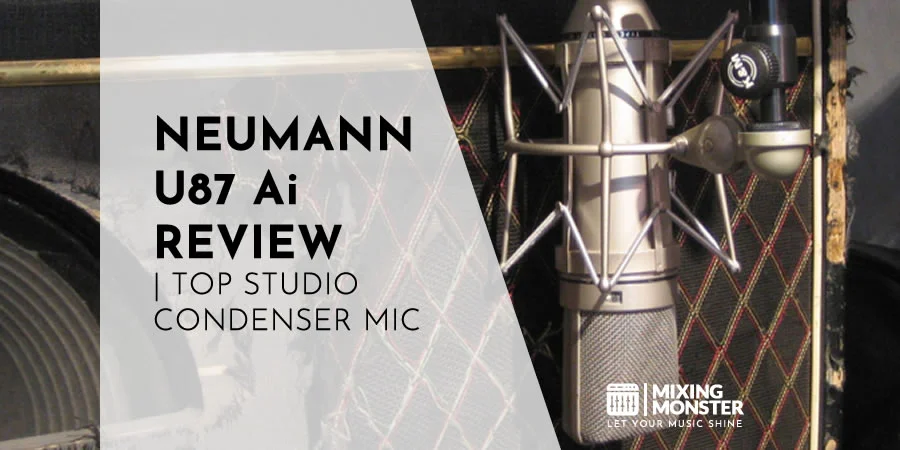

2. What Is A Studio Microphone?
A studio microphone is a device that converts sound waves into electrical signals. These signals can then be amplified, recorded, or transmitted. In a studio setting, microphones are indispensable for capturing clear and detailed sound, which is crucial for professional-quality recordings.
We categorize studio microphones into different types based on their transducer principles or directional patterns:
- Dynamic Microphones:
They are known for their durability and ability to handle high sound pressure levels. They are perfect for recording loud sources like guitar amplifiers and drums. - Condenser Microphones:
Offering wide frequency response and high sensitivity, these are ideal for capturing vocals and subtle nuances of acoustic instruments. - Ribbon Microphones:
These microphones are revered for their warm and natural sound. They excel in capturing high-frequency detail and are often favored for strings and brass.
The directional pattern of a microphone indicates how it picks up sound from various directions. Common patterns include:
- Cardioid:
It picks up sound from the front, less from the sides, and minimally from the back. It is excellent for isolating the desired sound source. - Omnidirectional:
This method captures sound equally from all directions, which is useful when we want a more ‘open’ and natural sound. - Figure 8:
It picks up sound from the front and back but rejects it from the sides, which is beneficial when recording two sources facing each other.
We consider a microphone’s frequency response and sensitivity to ensure it suits the intended application. A flat frequency response captures sound more accurately, while shaped responses can enhance certain aspects of the sound.
When we choose a studio microphone, we look for these technical specifications to ensure it meets our recording needs.
3. Studio Microphone Buying Guide
When selecting the best studio microphone, we need to consider several key features to ensure we choose to meet our recording needs.
Types Of Studio Microphones
Firstly, we assess the different types of microphones and what they are best at:
- Dynamic Microphones:
Best for loud, robust sounds. - Condenser Microphones:
Ideal for capturing vocal nuances and high frequencies. - Ribbon Microphones:
Excellent for warmth and vintage vibes.
Studio Microphone Polar Patterns
Understanding polar patterns when buying a microphone is crucial:
- Cardioid:
Captures sound from the front, good isolation. - Omnidirectional:
Picks up sound from all directions. - Figure 8:
Picks up sound from the front and back, rejects from the sides.
Technical Specs Of Studio Microphones
Make sure to review the technical specifications:
| Specification | Relevance |
|---|---|
| Frequency Response | Ensures the microphone can capture the range of sounds we need. |
| Sensitivity | Affects how well the microphone picks up quiet sounds. |
| SPL Handling | Shows the maximum volume before distortion occurs. |
Studio Microphone Connectivity
Consider the connectivity options:
- XLR Connection:
The professional standard requires an audio interface. - USB Microphones:
Convenient for direct connection to computers.
Additional Features
Lastly, we look at additional features such as:
- Built-In Preamps:
For boosting signal strength. - Pad Switches:
To reduce sensitivity for louder sources. - Filters:
Like low-cut filters to eliminate low-frequency noises.
By sifting through these aspects, we ensure our investment in a studio microphone is sound and suitable for our intended recording scenarios.
4. Finding Your Perfect Studio Microphone: Key Takeaways
When we’re in the market for a studio microphone, the first consideration is often the type. We have options like condensers and dynamic mics. Condensers are favored for their sensitivity and comprehensive frequency response, making them ideal for vocal recordings. Dynamics are more rugged and better for loud sound sources.
We must consider the polar patterns that will best serve our needs. Will we record in a controlled studio setting, or do we need a mic that’s forgiving with background noise? Here, we might choose between the following:
- Cardioid (captures sound in front of the mic)
- Omnidirectional (picks up sound from all directions)
- Bidirectional (picks up sound from the front and back)
Another critical factor is the connectivity. USB mics offer plug-and-play convenience, while XLR microphones require an audio interface but provide higher quality and versatility. Let’s consider our budget. If the microphone is a central tool in our studio, we should invest in higher quality. However, many affordable options provide excellent quality for beginner to intermediate levels.
Testing the microphone with our voice or instruments is essential since each mic has a unique color and may suit different timbres. Lastly, accessories are to be noticed. A good shock mount, pop filter, and stands can greatly enhance recording quality by reducing unwanted noise and vibrations.
Our Top Picks For The Best Studio Microphones
Best Budget Studio Microphones
Best Midrange Studio Microphones
- Shure BETA 58A
- Shure 55SH Series II Retro
- Sennheiser E906
- RØDE NT1 5th Generation
- Warm Audio WA-47jr
Best High-End Studio Microphones
5. FAQ
1) What criteria should I consider when choosing a microphone for studio recording?
When picking a microphone for studio recording, assess its polar patterns, frequency response, and sensitivity. It is crucial to match the mic’s features with the intended recording environment and the type of sound you aim to capture.
2) Which microphones are preferred by professionals for recording music?
Professionals often choose microphones such as the Neumann U87 for its versatility and the Shure SM7B for its warm, smooth sound. These mics have become industry standards due to their reliability and quality in capturing various vocals and instruments.
3) What top microphones are recommended for recording vocals in a home studio setting?
The Audio-Technica AT2020 provides excellent clarity for home studio vocals at an affordable price. At the same time, the Rode NT1-A is praised for its detailed acoustic capture and low noise level, making them top choices for vocalists.
4) What are the best options for microphones when creating content for YouTube?
YouTube content creators should look for microphones like the Blue Yeti for its ease of use and multiple pattern selection or the Elgato Wave:3 for its superior digital mixing capabilities, particularly for live streaming and podcasting.
5) Please suggest a microphone that delivers professional-quality vocals when used with a computer.
The Rode NT-USB is highly recommended for delivering professional-quality vocals with a computer. It combines studio-grade recording capabilities with the convenience of a USB connection, which is ideal for voiceover artists and podcasters.
6) How do I decide between a condenser and a dynamic microphone for studio work?
Choose a condenser microphone for studio work requiring detailed sound capture and a broader frequency range. Opt for a dynamic microphone if you’re recording loud sources or seeking durability and lower sensitivity to sound pressure levels.

